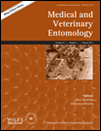Ver ítem
- xmlui.general.dspace_homeCentros Regionales y EEAsCentro Regional Santa FeEEA RafaelaArtículos científicosxmlui.ArtifactBrowser.ItemViewer.trail
- Inicio
- Centros Regionales y EEAs
- Centro Regional Santa Fe
- EEA Rafaela
- Artículos científicos
- Ver ítem
Management strategies to minimize the use of synthetic chemical acaricides in the control of the cattle tick Rhipicephalus (Boophilus) microplus (Canestrini, 1888) in an area highly favourable for its development in Argentina
Resumen
The aim of this work was to test the efficacy of winter-spring control strategies against Rhipicephalus (Boophilus) microplus (Canestrini, 1888) (Ixodida: Ixodidae) in an area highly favourable for its development in Argentina. Control schemes using three or four annual applications of synthetic acaricides were evaluated. Furthermore, the dynamics of the non-parasitic phases of R. microplus were analysed to provide a framework for the application of
[ver mas...]
The aim of this work was to test the efficacy of winter-spring control strategies against Rhipicephalus (Boophilus) microplus (Canestrini, 1888) (Ixodida: Ixodidae) in an area highly favourable for its development in Argentina. Control schemes using three or four annual applications of synthetic acaricides were evaluated. Furthermore, the dynamics of the non-parasitic phases of R. microplus were analysed to provide a framework for the application of pasture spelling as a tool for tick control. The treatment schemes provided appropriate levels of efficacy against R. microplus and also prevented the occurrence of the major peak in abundance of this tick in autumn. A significant overall effect against R. microplus can be achieved when the control strategies tested in this study are applied within the area most ecologically favourable for this tick in Argentina. Analysis of the dynamics of the non-parasitic phase of R. microplus indicates that the spelling period required to achieve a significant reduction of larvae in pastures fluctuates between 12 and 17 weeks if spelling is initiated in spring or early summer, but between 20 and 28 weeks if spelling is started in late summer, autumn or winter.
[Cerrar]

Autor
Fuente
Medical and Veterinary Entomology 1-15 (2020)
Fecha
2020-02
Editorial
Wiley
ISSN
0269-283X
1365-2915
1365-2915
Formato
pdf
Tipo de documento
artículo
Palabras Claves
Derechos de acceso
Restringido
 Excepto donde se diga explicitamente, este item se publica bajo la siguiente descripción: Creative Commons Attribution-NonCommercial-ShareAlike 2.5 Unported (CC BY-NC-SA 2.5)
Excepto donde se diga explicitamente, este item se publica bajo la siguiente descripción: Creative Commons Attribution-NonCommercial-ShareAlike 2.5 Unported (CC BY-NC-SA 2.5)

